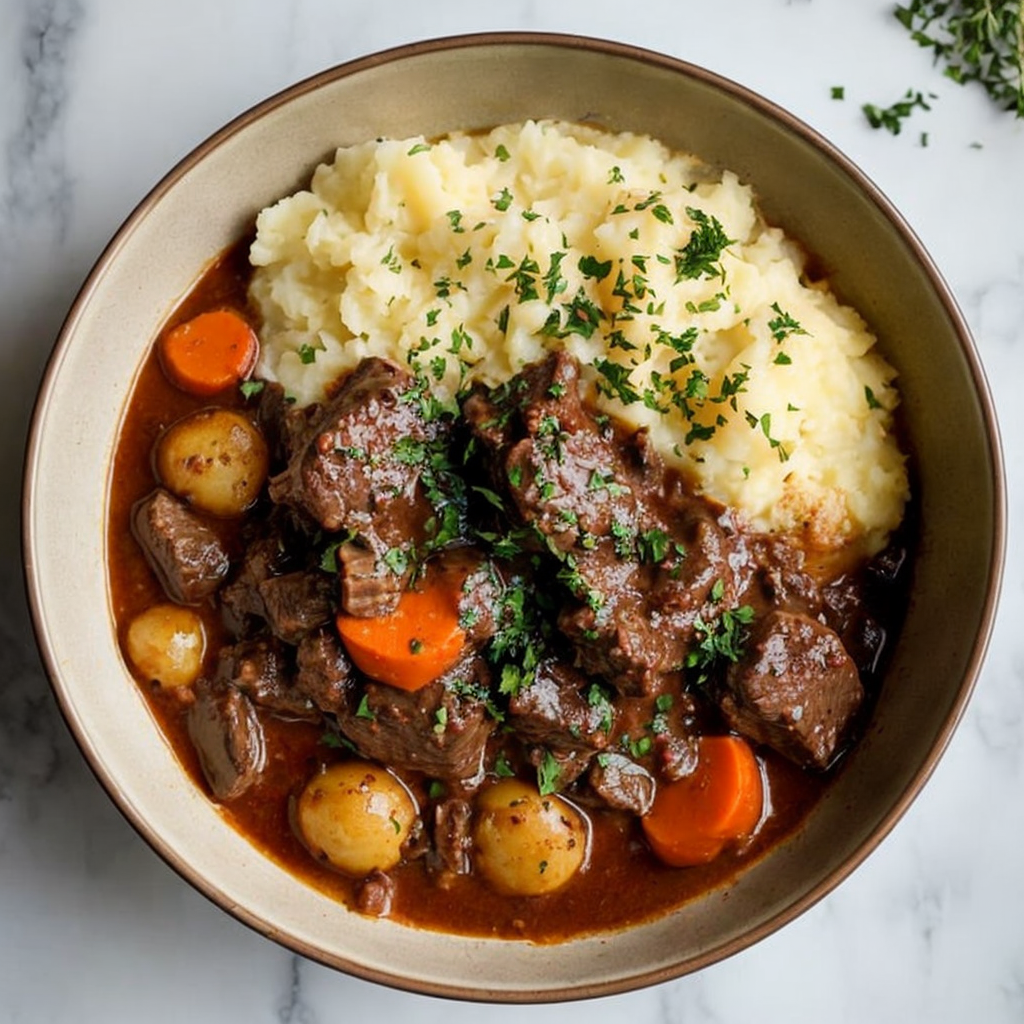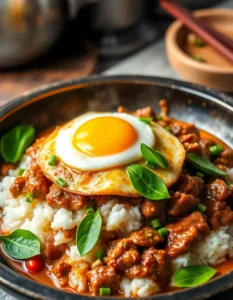Classic Beef Bourguignon – Ultimate Family Favorite Recipe
Escape to the heart of France with this Classic Beef Bourguignon recipe. Perfect for a family feast, this ultimate comfort dish combines tender beef, earthy mushrooms, and a rich, velvety sauce that will make your taste buds sing. Whether you’re gathering for a Sunday dinner or celebrating a special occasion, this meal creates an indulgent sensory experience that promises warmth and satisfaction.
Each bite of Beef Bourguignon tells a story of French culinary tradition, from the tenderness of slowly cooked beef to the robust depth provided by red wine. As the aroma fills your kitchen, you’ll be swept away to the quaint streets of Burgundy, where flavors meld together to create a symphony of taste.
Quick Recipe Highlights
- Flavor Profile: Savory, complex, and rich with a hint of sweetness from onions and carrots
- Texture: The beef is fork-tender, while the vegetables retain a satisfying bite
- Aroma: Earthy notes from mushrooms complemented by the fragrant bouquet of herbs
- Visual Appeal: A deep, glossy sauce enveloping brown beef and vibrant vegetables
- Skill Level Needed: Intermediate cooking skills required for searing and stewing
- Special Equipment: A heavy-duty Dutch oven or cast-iron pot for even cooking
Recipe Overview
- Difficulty Level: Moderately challenging due to the need for precise temperature control and timing
- Category: Main course, dinner
- Cuisine: French, specifically from the Burgundy region known for its wine-based stews
- Cost: Moderate cost due to premium cuts of meat and wine
- Season: Best enjoyed in cooler months for its warming, hearty nature
- Occasion: Ideal for family gatherings, special occasions, or a cozy weekend meal
Why You’ll Love This Recipe
The indulgent taste and rich texture of Classic Beef Bourguignon make it a beloved dish. The beef, slowly braised in red wine, becomes exquisitely tender, releasing flavors that are both deeply satisfying and comforting. The balance of savory and subtly sweet elements ensures that each spoonful is a delight.
Conveniently, this dish can be prepared ahead of time, allowing flavors to develop further. Its preparation, while somewhat time-consuming, is straightforward enough for even an enthusiastic home cook to manage. Much of the cook time involves hands-off simmering, leaving you free for other tasks.
Nutritionally, Beef Bourguignon is a generous source of protein and vegetables. Though considered an indulgence, it can be balanced with serving size adjustments to fit into a healthy diet. The use of fresh vegetables like carrots, onions, and mushrooms contributes vital nutrients and fiber.
Socially, this recipe is a show-stopper at dinners, offering both aesthetic appeal and delightful taste. Its storied lineage as a French culinary classic often inspires conversation, making it not just a meal but an experience to share with friends and family.
This dish is cost-effective for special occasions, as it transforms affordable cuts of beef into a luxurious, tasting meal. The wine doesn’t need to be expensive—just good enough to drink—ensuring accessibility without compromising flavor.
Historical Background and Cultural Significance
Beef Bourguignon traces its roots to Burgundy, France, famed for its wine and as the birthplace of this culinary masterpiece. Originally a peasant dish, it was designed to use tougher cuts of meat, transforming them into succulent bites through slow, loving cooking.
Culturally, Beef Bourguignon is more than a dish; it’s an emblem of French savor-faire, showcasing how simplicity can yield complexity. It highlights regional produce, marrying local wine with seasonal vegetables, paying homage to Burgundy’s fertile lands and rich history.
Over time, the recipe has undergone iterations, with various chefs adding their nuances. Julia Child famously introduced it to American kitchens, gaining fame through her book “Mastering the Art of French Cooking,” which democratized elaborate French dishes for home cooks.
Regional variations abound, with some versions incorporating pearl onions or altering the wine choice based on locale. Each rendition retains the fundamental unifying characteristics: slow cooking and sumptuous, wine-infused flavor, ensuring every slice of beef is a decadent experience.
Ingredient Deep Dive
**Beef**
The essence of Beef Bourguignon lies in its namesake, beef, traditionally chosen from tougher cuts like chuck or brisket. These sections are rich in collagen, which transforms into gelatin when slow-cooked, lending an irresistible tenderness and body to the dish. Selecting beef with a good marble of fat is essential for flavor, allowing the meat to self-baste as it cooks.
Nutritionally, beef offers high levels of protein, iron, and B vitamins, essential for energy and metabolism. When picking beef for Bourguignon, look for bright red hues, firm texture, and a fresh scent. Consider asking your local butcher for recommendations tailored to your taste and recipe requirements.
For storage, refrigerate beef in the coldest part of your fridge and use it within 2 days of purchase. Alternatively, freeze for up to six months, ensuring it’s well-wrapped to prevent freezer burn. If you need a substitute, consider lamb or venison for a similar texture with a slightly gamier flavor.
**Red Wine**
Choosing the right wine for Beef Bourguignon parallels selecting paint for a masterpiece. Burgundy’s own Pinot Noir is the traditional choice, offering a balance between fruitiness and acidity, essential for tenderizing the meat while enhancing its flavor profile. However, other medium-bodied varieties, such as Merlot or Cabernet Sauvignon, work beautifully if you’re looking to experiment.
Red wine in cooking not only elevates the dish’s taste but also adds antioxidants, known for their cardiovascular benefits. Opt for a wine you’d enjoy drinking, as its quality will influence the final taste of the stew. Keep it stored in a cool, dark place and once opened, refrigerate and use within a few days for optimal flavor.
For accommodations, grape juice with a splash of vinegar can substitute the wine, although the complexity will differ. Alternatively, a rich beef stock enriched with a tablespoon of tomato paste offers a non-alcoholic option that still imparts depth to the dish.
Common Mistakes to Avoid
- Skipping the browning step can lead to a lack of depth in the dish’s flavor. Always sear the beef to caramelize its surface.
- Overcrowding the pan during searing prevents proper browning—work in batches to achieve a perfect crust.
- Using old or low-quality wine can impart an undesirable taste. Choose a wine you’d happily sip on.
- Not allowing the beef sufficient time to cook may result in tough meat. Patience is key for tender results.
- Under seasoning can cause the flavors to fall flat. Taste as you go and adjust seasoning accordingly.
- Using tough or very large pieces of vegetables leads to uneven cooking; ensure a consistent cut size.
- Foregoing the aromatic bouquet garnis diminishes herbaceous notes essential to balance the wine’s acidity.
- Erratic cooking temperature altering from high to low can shock the meat, affecting its tenderness. Maintain a consistent simmer.
Essential Techniques
**Searing the Beef**
The process of searing is crucial for developing a rich, flavorful “Maillard” crust on the beef, which locks in juices and enhances the dish’s savory notes. To master the technique, ensure your pan is sizzling hot before the beef hits the surface. Avoid crowding to maintain high heat, allowing each piece to caramelize properly. Use visual cues like a deep brown color and crisp edges to signal readiness.
**Deglazing the Pan**
Deglazing involves adding a liquid, often wine, to the hot pan to scrape up flavorful bits left behind after searing. This step is vital for infusing the dish with depth, adding both moisture and complexity. Mastering this technique requires patience; allow the wine to simmer briefly, loosening the caramelized particles while avoiding burning or evaporating the liquid too quickly.
Pro Tips for Perfect Beef Bourguignon
– Always use a heavy-bottomed pot that evenly distributes heat, preventing hot spots that can burn the dish.
– Marinate the beef in wine overnight for an even deeper flavor, ensuring it fully absorbs the wine’s aromatic compounds.
– Choose fresh herbs over dried ones for the bouquet garnis to enhance the freshness and vibrancy of the dish’s aroma.
– Opt for pearl onions for added sweetness and aesthetic charm, complementing the beef’s robust taste.
– Stir gently during cooking to maintain the integrity of the vegetable textures without mashing softer elements.
– Allow the dish to rest after cooking, as flavors will meld and intensify, with next-day consumption often proving more delicious.
– Consider serving over mashed potatoes or buttered noodles to soak up the delectable juices.
– Re-heat slowly, using low heat to preserve the tender texture and prevent overcooking.
Variations and Adaptations
Regional Variations
Traditional Beef Bourguignon is famed in Burgundy, yet variations span across France. In Provence, rosemary is added for an aromatic twist, while in the Loire Valley, mushrooms are emphasized further to local taste. These variations provide a distinctive regional flair, complemented by their local produce.
**Seasonal Adaptations**
In warmer months, lighten the dish by reducing the red wine and incorporating a touch of balsamic vinegar for freshness. Summer vegetables such as fresh bell peppers or zucchini can be added, offering a brighter, seasonal adaptation.
**Dietary Modifications**
To accommodate different diets, consider creating a gluten-free version by replacing wheat flour with cornstarch when thickening the sauce. For a lower-calorie dish, trim excess fat from the beef and increase vegetable quantity to boost fiber content.
**Flavor Variations**
Experimenting with different herb combinations can invigorate the traditional beef stew. For a Mediterranean twist, include rosemary and olives, giving the classic a refreshing depth reminiscent of sunny coastlines.
**Texture Modifications**
For a more hearty texture, add root vegetables like parsnips or turnips, which offer both bulk and subtle sweetness. Conversely, purée the broth portion slightly for a smoother texture without altering the dish’s character.
**Presentation Alternatives**
An elegant presentation can elevate this rustic dish to a dinner party centerpiece. Serve in individual ramekins, topped with puff pastry lids for a dramatic look, or garnish with a sprig of fresh thyme for a sophisticated touch.
Serving and Presentation Guide
Plating Techniques
To artfully plate Beef Bourguignon, spoon a generous portion into shallow bowls, ensuring the beef and vegetables are prominently visible. Artistically drizzle extra sauce over the dish, allowing it to pool along the edges for visual appeal.
**Garnishing Ideas**
A light sprinkle of fresh parsley or thyme over the dish provides a pop of color and a hint of freshness. For added depth, a dollop of crème fraîche can complement the richness of the sauce, bringing balance to the palate.
**Traditional Accompaniments**
Mashed potatoes, crusty French bread, or broad egg noodles are ideal accompaniments, each serving as a canvas to enjoy the luscious sauce. These traditional sides enhance the experience, soaking up every last drop.
**Modern Serving Suggestions**
Consider presenting Beef Bourguignon on a bed of creamy polenta or pairing it with a simple arugula salad, adorned with toasted walnuts. These modern interpretations offer a lighter touch without sacrificing flavor.
**Temperature Considerations**
Ensure the dish is served piping hot to unlock its full aromatic potential. Equally, warmed serving bowls can assist in maintaining the ideal temperature throughout the meal.
**Portion Control Tips**
Mindful portions allow for indulgence while maintaining balance. Serving in small, individual dishes or ramekins helps manage intake, providing satisfaction without overconsumption.
Wine and Beverage Pairing
**Wine Pairings**
A classic red Burgundy or Pinot Noir mirrors the dish’s cooking wine, amplifying nuances and harmonizing with the beef’s richness. Alternatively, a Côtes du Rhône offers a spicy contrast that invigorates the palate.
**Non-alcoholic Alternatives**
For alcohol-free alternatives, a hearty grape juice, slightly thinned with water, mirrors the dish’s robust character. Similarly, a tart cranberry or pomegranate juice complements with its acidity.
**Coffee/Tea Pairings**
Post-meal, an espresso or a smoky Lapsang souchong tea cleanses the palate, bridging traditional and contemporary tastes while providing a warming conclusion.
**Temperature Considerations**
Both red wines and non-alcoholic juices should be served at room temperature to ensure flavors remain bold without the chill masking their complexities.
**Serving Suggestions**
Use large, round-bowled wine glasses, allowing the wine’s aromas to concentrate and intensify with each swirl. Offer side carafes for additional wine or juice, promoting leisurely and interactive dining.
Storage and Shelf Life
Proper storage extends the life of Beef Bourguignon, ensuring the enjoyment of leftovers. Refrigerate in an airtight container for up to three days, allowing flavors to deepen. Ensure reheating is gentle and gradual, maintaining texture and preventing meat from toughening.
For extended storage, the dish freezes well. Portion into containers, removing excess air before sealing. Label with the date to track freshness, and consume within three months for optimal taste.
Signs of spoilage include an off-smell or discolored, mushy vegetables. In such cases, cautionarily discard to prevent foodborne illness.
Reheating should maintain a low simmer to preserve the dish’s integrity. Stir occasionally to distribute heat evenly. If frozen, thaw overnight in the refrigerator before reheating.
Make Ahead Strategies
This dish is a star candidate for meal prep, benefiting from make-ahead assembly. Prepare elements such as browning meat and chopping vegetables a day in advance, storing each component separately.
Store within appropriately sized containers to control space and freshness. Maintain separation until cooking to avoid mixing flavors prematurely.
Quality is preserved with make-ahead steps, typically intensifying as it melds in the fridge. The end result is often even more flavorful than freshly cooked.
When reassembling, follow preparation steps with a focus on revitalizing each ingredient’s profile. Refresh with additional fresh herbs before serving to enhance aroma and appearance.
Reheating requires attention to subtle seasoning adjustments, ensuring the finished dish remains as delectable as intended.
Scaling Instructions
Beef Bourguignon’s flexibility shines in scalability, accommodating larger or smaller gatherings. For halving, adjust ingredient quantities consistently, ensuring flavors remain balanced without overwhelming any single component.
Doubling or tripling demands attention to pan size, potentially requiring a second pot or batch cooking to avoid crowding.
Time adjustments are necessary, particularly in extended cook times for larger batches. Monitor simmering phases, adapting as thickness or reductions vary.
Storage considerations become vital when scaling, with larger batches necessitating multiple containers and labeling for effective management.
Understand that seasoning intensity must be aligned with volume changes—taste frequently to ensure the complexity is neither lost nor overpowering.
Nutritional Deep Dive
A classic comfort food, Beef Bourguignon provides a comprehensive distribution of macronutrients. Protein-rich beef offers muscle-building benefits. Vegetables contribute vitamins, minerals, and fiber, supporting digestion and overall health.
A balanced serving contains sustainable carbohydrates and moderate fat, aligning with dietary needs provided portions are mindful.
Micronutrient analysis highlights the dish’s offerings in B vitamins, iron, and antioxidants. Part of a balanced meal plan, Beef Bourguignon accommodates multiple diet patterns without significant alterations.
Overall, its nutrient density satisfies both the appetite and nourishment requirements, provided it’s enjoyed in appropriately sized portions.
Dietary Adaptations
**Gluten-free**
Opt for gluten-free flour or cornstarch for sauce thickening, ensuring celiac-friendly consumption without losing its luxurious texture.
**Dairy-free**
Traditional recipes are naturally dairy-free; however, if using butter, substitute with a plant-based alternative such as olive oil to achieve a similar result.
**Vegan**
Convert Beef Bourguignon to a vegan delight with mushroom, seitan, or tempeh substitutes for meat and vegetable broth instead of beef stock.
**Low-carb**
For low-carb diets, reduce starch-heavy vegetables and enease sugar by focusing on non-starchy counterparts like onions and mushrooms.
**Keto**
Enhanced through fat-rich additions, consider adding bone broth or cocoa butter to increase fat content while retaining authenticity and ketogenic compatibility.
**Paleo**
For a paleo approach, substitute traditional wine with a non-alcoholic cider or plum juice, paired with grass-fed beef and organic produce.
**Low-FODMAP**
Choose low-FODMAP veggies like zucchini, and replace onions with chives to maintain a gentle profile suitable for sensitive stomachs.
The Recipe
Classic Beef Bourguignon
Serves: 6
Prep Time: 30 mins
Cook Time: 180 mins
Total Time: 210 mins
Kitchen Equipment Needed
- Heavy-duty Dutch oven
- Sharp knife
- Cutting board
- Wooden spoon
- Measuring cups
- Bowls for preparation
Ingredients
- 2 lbs beef chuck, cut into 2-inch cubes
- Salt and pepper to taste
- 2 tbsp olive oil
- 1 onion, diced
- 2 carrots, sliced
- 8 oz button mushrooms, quartered
- 2 cloves garlic, minced
- 2 tbsp tomato paste
- 2 cups red wine
- 2 cups beef broth
- 3 thyme sprigs
- 2 bay leaves
- 2 tbsp flour
- 1/4 cup fresh parsley, chopped
Directions
- Season beef cubes with salt and pepper. Heat olive oil in a Dutch oven over medium-high heat. Sear beef in batches, ensuring a browned crust. Remove and set aside.
- In the same pot, add onion, carrots, and mushrooms. Sauté until onion is soft. Add garlic and cook for 1 minute.
- Stir in tomato paste, followed by flour, coating vegetables evenly. Cook for 2 minutes.
- Pour in red wine, deglazing the pot and scraping up any browned bits. Bring to a simmer.
- Return beef to the pot. Add beef broth, thyme, and bay leaves.
- Cover and simmer on low for 2.5 to 3 hours, or until beef is fork-tender.
- Discard thyme sprigs and bay leaves before serving.
- Garnish with fresh parsley and serve hot.
Recipe Notes
- For a thicker sauce, simmer uncovered for the last 30 minutes.
- Substitute pearl onions for added sweetness.
- Pair with crusty bread to soak up the flavorful sauce.
Troubleshooting Guide
**Texture Issues**
If your beef is tough, it likely needs more cooking time. Ensure a gentle simmer, allowing connective tissues to break down, fostering tenderness. Conversely, overly mushy vegetables denote overcooking—monitor their doneness and remove earlier if necessary.
**Flavor Balance**
A bland dish often signals insufficient seasoning. Add incremental salt and pepper, or a teaspoon of vinegar, to enhance flavors without overpowering the dish’s subtlety.
**Temperature Problems**
Burnt edges suggest excessive heat. Adjust burner temperature to maintain a gentle simmer. Alternatively, using a thicker pot with even heat distribution safeguards against burning.
**Equipment Challenges**
If a Dutch oven isn’t available, a heavy-bottomed stock pot can suffice. Keep in mind it retains heat differently, potentially requiring vigilant temperature adjustments.
**Ingredient Substitutions**
Missing red wine? Consider using beef broth with a splash of balsamic vinegar or grape juice for a non-alcoholic option that maintains a similar complexity.
**Timing Concerns**
Timing is crucial—under one hour of simmering insufficiently breaks down tough cuts. Aim for 2-3 hours, ensuring beef becomes melt-in-your-mouth tender by the finish.
Recipe Success Stories
This recipe has become a staple during holiday feasts, with readers sharing adaptations like incorporating herbs from their gardens for a personal touch. Photographers capture the dish’s radiant color contrasts, enhancing its appeal on social platforms, sparking conversations and inspiring home chefs to try their hand at this classic.
A notable reader suggestion involved substituting the typical serving with creamy risotto, which was hailed for its luxurious pairing, garnering rave reviews across culinary websites and social media alike.
Frequently Asked Questions
Can Beef Bourguignon be made a day ahead? Absolutely. This dish improves in flavor with time, offering a delightful complexity the following day. Store in the refrigerator and reheat gently.
What can I use instead of red wine? For non-alcoholic versions, use beef stock with a splash of balsamic vinegar or grape juice for a depth of flavor.
How can I thicken the sauce? Simmer uncovered for the last 30 minutes or mix a tablespoon of cornstarch with water, adding and stirring until desired consistency.
Can I use other cuts of beef? Yes, tougher cuts like brisket or ribs work well, requiring similar slow-cooking techniques for tenderness.
What sides go best with it? Traditional sides include mashed potatoes, egg noodles, or a crusty baguette to soak up the sauce.
Can it be frozen? Indeed, it freezes beautifully. Ensure airtight containers or freezer bags are used, with portions retained for up to three months.
Why is my Beef Bourguignon liquid watery? Aim for a steady simmer, allowing liquids to reduce naturally. Thicken with a cornstarch slurry if necessary.
What vegetables can I substitute? Swap carrots and onions for parsnips, turnips, or pearl onions depending on what’s available seasonally.
Do I need to marinate the beef? While not essential, marinating overnight in wine can enhance the flavor depth and tenderness.
Does the type of wine matter? Ideally, choose a wine you’d drink. Medium-bodied reds like Pinot Noir or Merlot are excellent choices, affecting the final taste quality.
Additional Resources
For a deeper dive into French cuisine, consider exploring similar recipes like Coq au Vin or Ratatouille. Technique guides focusing on braising and sauce reduction can refine your skills, while ingredient spotlights on wines or herbs broaden understanding.
Engage with culinary communities for shared tips on alternative ingredients, and review equipment such as Dutch ovens or cast-iron pots essential for perfecting this beloved classic.
Join the Conversation
Engage with fellow culinary enthusiasts through our online community. Share your experiences and adaptations of Classic Beef Bourguignon by using targeted social media platforms. Experiment with photography tips shared by our readers, capturing your dish’s presentation in vibrant hues and textures.
We welcome recipe reviews, critiques, and suggestions for improvement. Participate in discussions on ingredient substitutions and variations, enriching your understanding of this exquisite recipe while inspiring others with your creative journey.



